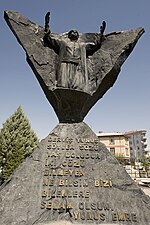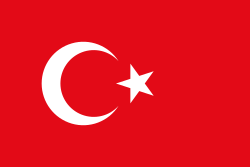Karaman
| Karaman | |
|---|---|
 Ulice Karamanu | |
| Poloha | |
| Souřadnice | 37°10′45″ s. š., 33°13′21″ v. d. |
| Nadmořská výška | 1014–1140 m n. m. |
| Stát | |
| Region | Střední Anatolie |
| Provncie | Karaman |
| Rozloha a obyvatelstvo | |
| Počet obyvatel | 141 630 (2012) |
| Správa | |
| Starosta | Savaş Kalaycı |
| Některá data mohou pocházet z datové položky. | |
Karaman je město v Turecku ve Střední Anatolii v provincii Karaman. Leží v podhůří Taurusu, 120 km severně od břehů Středozemního moře, 220 km východně od Antálie, 300 km jižně od Ankary. Roku 2012 mělo město 141 630 obyvatel. Cestovní ruch Karamanu je zajištěn zejména kulturní stránkou města.[1]
Historie
Původně řecké město se nazývalo Laranda (Λάρανδα).[2] Od 6. století př. n. l. bylo město pod vládou Achaimenovců. Po pádu Makedonské říše bylo zničeno Perdikkásem poté, co porazil kappadockého krále Ariarathese. Jako držitelé města Larandy se poté vystřídali Římská říše, Byzantská říše, Seldžucká říše, Fridrich I. Barbarossa, nebo Arménské království v Kilíkii.
Roku 1256 byla Laranda dobyta oghuzskými Turky a jejich vůdce Karamanoğlu Mehmet Bey ji po sobě přejmenoval na Karaman a jako jediný jazyk města zavedl turečtinu.[1] Tou dobou zde trávil konec života Junus Emre a pravděpodobně je zde i pohřben. Roku 1468 Karaman padl do rukou osmanských Turků. Od té doby dodnes je město turecké.
Pamětihodnosti
- Karamanská pevnost
- Památník Junuse Emreho
- Karamanská pevnost zvenku
- Karamanská pevnost zevnitř
- Památník Junuse Emreho
Odkazy
Externí odkazy
 Obrázky, zvuky či videa k tématu Karaman na Wikimedia Commons
Obrázky, zvuky či videa k tématu Karaman na Wikimedia Commons
Reference
Tento článek čerpá z 11. vydání Encyclopædie Britannicy z roku 1911, nyní již volného díla (public domain), z hesla (anglicky) „Karaman“, jehož autorem je Hugh Chisholm.
V tomto článku byl použit překlad textu z článku Karaman na anglické Wikipedii.
- ↑ a b USLU, Melih. Karaman The Capital Of The Turkish Language. Skylife [online]. 2014-07 [cit. 2021-05-05]. Dostupné v archivu pořízeném z originálu dne 2021-05-05. (anglicky)
- ↑ UMAR, Bilge. Türkiye'deki Tarihsel Adlar. [s.l.]: İnkılap Kitabevi, 1993. Dostupné online. ISBN 975-10-0539-6. (tu)
Média použitá na této stránce
Autor: Dosseman, Licence: CC BY-SA 4.0
I was taking a rest outside the citadel, which was closed, when a garden worker kindly warned me that the major was visiting the citadel, together with a foreign delegation. So the gate would be opened. I just joined the group, took some pictures and had a short chat with the major, after I told a Dutch representative that in my guidebook there was a reference to medieval houses surrounding the citadel: they had obviously disappeared. Yes, the major explained, they had been demolished 20 years ago (the guidebook is very thorough, but indeed stems from the late 80’s). But he promised that the area near the citadel would be landscaped anew, giving it a more pleasant aspect.
Karaman Castle (named ‘Iç Kale’ = Inner Castle) was the citadel of the medieval city. It is built on a slightly elevated hill (maybe a ‘höyük’ = artificial mound, result of long-term human settlement). According to the scarce historical sources, it seems to have been built around the early 12th century (Seljuk era). It has nine towers (four circular and five square ones). Like most fortresses, it has been repaired many times –recent restorations took place in 1961, 1975 and from 2010 on. During Karamanoğlu rule, a double set of city walls were erected: ‘Orta Kale’ (Middle Castle) had two gates and 40 towers and encircled an area with Iç Kale in its very centre. One of those gates (Pazar Kapısı = Market Gate) survived and has been restored. The second city walls ‘Dış Kale’ (Outer Castle) were grand, stretching about 5 km; Evliya Çelebi (1611-1682), the famous Turkish writer/traveller, described them in 1648 as having “140 towers and 9 city gates”. Alas, almost nothing of these remains.
Source: ‘Karaman (Tarihi ve Kültürü)’ (Ilhan Temizsoy & M. Vehbi Uysal) – Konya 1981 .Autor: Dosseman, Licence: CC BY-SA 4.0
The Eski Kütüphane (reading room). It will after some restoration house the city museum.
The building dates from the early 20th century. During the first decades of the Turkish Republic, it housed the Çiftçi Bankası (Farmer’s Bank) in one part, and the Karaman Kaymakamlık (District Government) in the other.
In the 2nd half of the 20th century, it became the ‘Yunus Emre Kütüphanesi’ (Library; Yunus Emre being a famous 13th/14th century poet and Sufi mystic, who lived in Karaman for a number of years). The library was accommodated elsewhere in the late 1990s, and the building was left empty, except for the ground floor which was turned into a number of small shops. In 2013 it was under restoration.Autor: Dosseman, Licence: CC BY-SA 4.0
Yunus Emre monument, three sided: this side holds a poem by Yunus Emre. It is claimed his grave is in the Yunus Emre Mosque (1349). From the Enc. Britt.: Though legend obscures the facts of his life, he is known to have been a Ṣūfī (Islāmic mystic) who sat for 40 years at the feet of his master, Tapduk Emre. Yunus Emre was well versed in mystical philosophy, especially that of the 13th-century poet and mystic Jalāl ad-Dīn ar-Rūmī. Like Rūmī, Yunus Emre became a leading representative of mysticism in Anatolia but on a more popular level; he was venerated as a saint after his death. His poems, which are devoted mainly to the themes of divine love and human destiny, are characterized by deep feeling. He wrote in a straightforward, almost austere style and mainly in the traditional syllabic metre of Anatolian folk poetry. His verse had a decisive influence on later Turkish mystics and inspired the poets of the renaissance of Turkish national poetry after 1910.
Autor: Dosseman, Licence: CC BY-SA 4.0
I was taking a rest outside the citadel, which was closed, when a garden worker kindly warned me that the major was visiting the citadel, together with a foreign delegation. So the gate would be opened. I just joined the group, took some pictures and had a short chat with the major, after I told a Dutch representative that in my guidebook there was a reference to medieval houses surrounding the citadel: they had obviously disappeared. Yes, the major explained, they had been demolished 20 years ago (the guidebook is very thorough, but indeed stems from the late 80’s). But he promised that the area near the citadel would be landscaped anew, giving it a more pleasant aspect.
Karaman Castle (named ‘Iç Kale’ = Inner Castle) was the citadel of the medieval city. It is built on a slightly elevated hill (maybe a ‘höyük’ = artificial mound, result of long-term human settlement). According to the scarce historical sources, it seems to have been built around the early 12th century (Seljuk era). It has nine towers (four circular and five square ones). Like most fortresses, it has been repaired many times –recent restorations took place in 1961, 1975 and from 2010 on. During Karamanoğlu rule, a double set of city walls were erected: ‘Orta Kale’ (Middle Castle) had two gates and 40 towers and encircled an area with Iç Kale in its very centre. One of those gates (Pazar Kapısı = Market Gate) survived and has been restored. The second city walls ‘Dış Kale’ (Outer Castle) were grand, stretching about 5 km; Evliya Çelebi (1611-1682), the famous Turkish writer/traveller, described them in 1648 as having “140 towers and 9 city gates”. Alas, almost nothing of these remains.
Source: ‘Karaman (Tarihi ve Kültürü)’ (Ilhan Temizsoy & M. Vehbi Uysal) – Konya 1981 .








